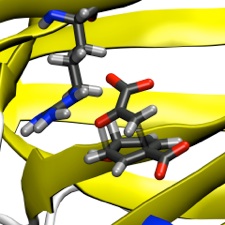CCPBioSim Training Workshop:
QM/MM Methods for Modelling Enzyme-Catalysed Reactions

CCPBioSim Training Workshop:
QM/MM Methods for Modelling Enzyme-Catalysed Reactions
In this workshop, you will learn how to apply combined quantum mechanics/molecular mechanics (QM/MM) methods to model a chemical reaction in an enzyme. You will calculate energy profiles for the reaction, and analyse important interactions at the active site. The results will be used to examine transition state stabilization in the enzyme.
Aims of the Workshop
Use QM/MM methods to model enzyme-catalysed chemical reactions.
Understand catalysis in terms of changes in activation energy, and how to rationalise changes in activation energy in terms of interactions between molecules (in this case, between the enzyme and the substrate).
Methods Used
CHARMM: a key piece of computational chemistry software that is often used to model enzyme-catalysed reactions. (Other software could also be used, such as the AMBER-suite of programs.)
AM1 (within CHARMM): a semi-empirical quantum mechanical method (used here mostly for speed).
Structural and energetic analysis of reaction paths and comparison of calculations and experimental data.
Systems Studied
Reaction of chorismate to prephenate catalysed by the enzyme chorismate mutase, in the condensed phase.
Reaction of chorismate to prephenate in the gas-phase.

12th Sept 2014
Merchant Venturers Building (MVB), University of Bristol (BS8 1UB)
Marc van der Kamp (School of Chemistry)